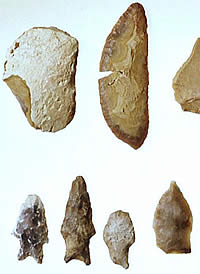Sleeper Site
The Sleeper site (41BC65) sits on a low terrace of West Walnut Creek, a small tributary of the Colorado River, in northern Blanco County. Archeologists from the State Department of Highways and Public Transportation (now TXDOT) conducted excavations there in 1976. Some years later, the site materials were analyzed and reported by LeRoy Johnson. The recovered artifacts date mainly to the later part of the Early Archaic period (roughly 6,000 to 4,000 B.C.) and include milling stones, dart points and blade tools as well as stone tool manufacturing debris (flakes, chips, etc.).
Burned rocks from hot rock cooking were common in the deposits and formed a distinct layer marking the main period of prehistoric site use. Within the rock layer were distinctive clusters of burned rock representing the remains of small circular cooking hearths and somewhat larger and less orderly burned rock accumulations that Johnson called baking heaps. Numerous freshwater mussel (clam) shells and Rabdotus land snail shells were recovered as well as a few fragments of bison and deer bones.
Given the large number of milling stones found at the site (38 metates, 70 manos) and the relative shortage of bison and deer remains, Johnson argued that the prehistoric inhabitants of the Sleeper Site were mainly collecting and processing local plant foods while camped at this site. Due to the proximity of many of these milling tools to baking heap features, he inferred that the milled food was cooked or baked on site. No plant remains were recovered at Sleeper, but Johnson reasoned that grass and herb seeds were probably the main targeted food resource based on the wear patterns found on the milling stones. Johnson interpreted the Sleeper site as a seasonal, short-term occupation locality geared towards the gathering and processing of local plant foods.
References:
Johnson, LeRoy, Jr.
1991 Early Archaic Life at the Sleeper Archaeological Site, 41BC65 of the Texas Hill Country Blanco County, Texas. Texas State Department of Highways and Public Transportation Highway Design Division, Publications in Archaeology Report No. 39, Austin.


